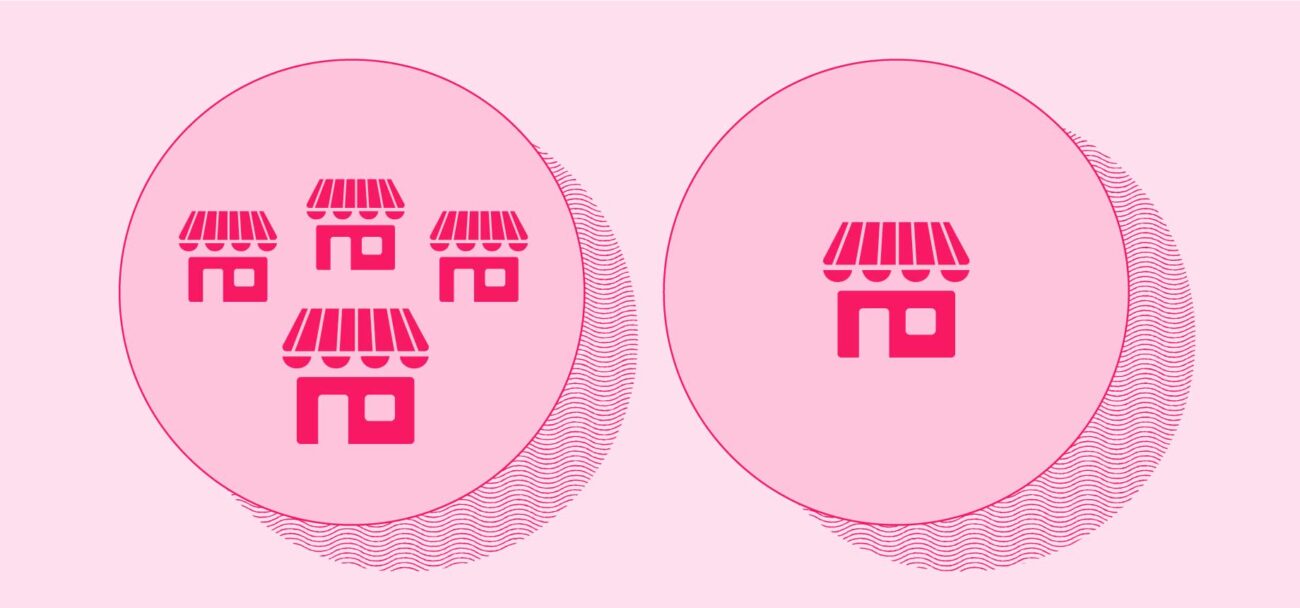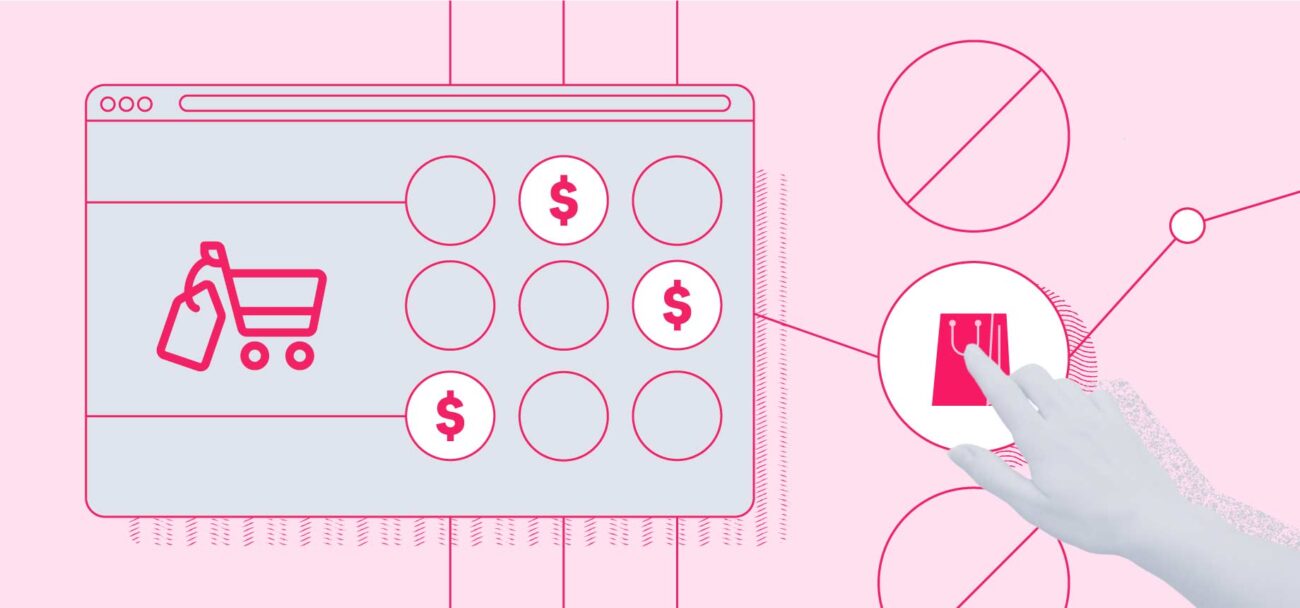
Marketplaces (also known as e-marketplaces or online / digital marketplaces) are an established business model in the commerce industry. We’ve written extensively on the subject, but here is a quick and simplified overview to get you started:
With these basic notions covered, it’s time to deep dive into the many types of marketplaces, note the differences and similarities between them and also how these can mix with one another.
Independent marketplaces (having alternative titles such as pure marketplaces, standalone marketplaces or the confusing third-party marketplaces) are those digital-native initiatives that were designed to only sell third-party inventory from the start. They are first and foremost operators and orchestrators, as by default they own no brands or inventory (although later on they may choose to chase that, too, like Amazon, ASOS and plenty others did).
However, they do sometimes hold inventory of third-party sellers in proprietary warehouses to facilitate faster fulfillment. A brand can therefore integrate into these operations and become a third-party seller (i.e. this is known as the Marketplace Out model of integration).
italist, a luxury marketplace that ships directly from Italian boutiques, fits the bill and so do Ububba and Palmer Jane, VTEX customers that sell k-baby and cannabis-based products, respectively.
The concept of integrated marketplaces, sometimes called enterprise marketplaces, presents us with a scenario in which traditional brands and retailers have decided to integrate the inventory of other brands, thus becoming online marketplaces themselves (i.e. the Marketplace In model of integration). The marketplace business is simply a new sales channel added to an existing ecommerce operation that they have full control over, helping to diversify stock and acquire new customers.
For instance, C&A Brazil, on top selling its branded products online, set up a proprietary marketplace by integrating over 150,000 SKUs from different brands in just a few months, with the help of VTEX’s fully-integrated ecommerce-marketplace-OMS capabilities.
Brands and retailers that shifted their strategy to integrate external inventory on their websites have grown more in 2020 than those that steered away from this new trend — 81% compared to the overall YoY ecommerce growth of 40%. Additionally, adopting the marketplace model also led to a 34% increase in site traffic for these traditional retailers.

An important note to make before moving on is that the aforementioned Marketplace In and Marketplace Out models are not mutually exclusive. A brand can build its own marketplace while also integrating its inventory into another marketplace. SONY, for example, does both successfully.
Based on target audience, the business-to-consumer marketplace is the most prevalent type of marketplace there is. Here, businesses sell their products to the end-consumer via the marketplace platform, just like the name promises. Booking.com, JD.com, Alibaba are just a few famous examples of this type.
VTEX also supports plenty of B2C marketplaces. For instance, Mazda Motor Europe is in the process of setting up these channels in 22 European countries. Carrefour Brazil also has a highly successful marketplace with more than 3000 third-party sellers and four million SKUs.
Although still a novelty, business-to-business marketplaces are quickly gaining traction, especially in sectors where wholesale plays an important role. All in all, worldwide B2B marketplace sales are estimated to reach $3.6 trillion USD by 2024, as giant manufacturers are digitalizing their supply chains to ease transactions with distribution partners and sellers in the post-pandemic era of retail.
In the VTEX ecosystem, Unilever Spain created a digital B2B marketplace that connects retailers with distributors of its products. There is also bisco, which constructed a B2B marketplace with millions of SKUs to provide a best-in-class experience for manufacturing procurement of fasteners, electronic components and hardware.
B2C and B2B are not the sole players — peer-to-peer (or consumer-to-consumer) marketplaces are also considerably common. On these marketplaces, buyers and sellers alike are private consumers and both products and services can be sold. Instantly-recognizable names include Uber, Etsy, Airbnb, Fiverr, Depop, Shpock and Vinted, the latter three helping out the sharing economy in tremendous ways.

Horizontal marketplaces are marketplaces that offer products from numerous different industries, sort of like department stores into a single shopping mall. A subtype here is the one-stop-shop, which aims to cover a majority of the customer’s needs by offering a wide range of products, from furniture and grocery to electronics and fashion and everything in between.
Amazon and AliExpress are the perfect examples of a horizontal marketplace, as you can find anything and everything on their websites. If we look at VTEX customers, we can also list several:
Unsurprisingly given the name, this type of marketplace focuses on a single vertical. This narrow focus tames down competition between vendors while also allowing the customer to benefit from a smoother product discovery process, because the shopping experience is not polluted by items that do not match their initial needs. For the perfect fit, you could go directly to StockX’s sneaker marketplace, for example.
Such marketplaces can be started regardless of industry, but here’s an in-depth analysis of the main fashion marketplaces currently blazing a trail.

At the bridge between horizontal and vertical marketplaces lies an intermediate type: complementary marketplaces. These are online stores that stretch across two or a small number of industries (so, not quite one-stop-shops), offering products that complement one another. Examples from VTEX customers include:
Open marketplaces (or unmanaged marketplaces) are those that accept virtually all third-party sellers that apply to sell on their online platforms. With little to no filtering, the onboarding process is so straightforward that retailers and brands could sell on these websites in mere minutes. Amazon once again fits this description and so do most P2P marketplaces offering products (with services, there are higher risks).
However, there are a few downsides to this ease of onboarding. Firstly, the marketplace can quickly become oversaturated and messy for the shopper to navigate unless powerful search engines and filtering and sorting capabilities are implemented.
Secondly, from the perspective of the seller, with such high competition, there’s a risk of being lost amongst an endless sea of suppliers. Think about when you shop on Amazon: there are often numerous listings for the same product — and let’s face it, who actually goes past the second page of search results? Sellers that remain undiscovered might find being available on these marketplaces not so advantageous.
Thirdly, with unverified sellers, the marketplace is ripe for scams ranging from fake customer reviews to non-existent products. Additionally, without ensuring sellers have good flows for order fulfilment in place, the marketplace’s customer service team can be overwhelmed with queries related to missing or delayed parcels and product accuracy.

Closed marketplaces (or managed marketplaces) are those that heavily curate their third-party sellers. Despite the constant struggle to partner with more and more third-party sellers in order to ensure profitability, most online marketplaces are extremely cautious of whom they let inside their home, so to speak. Why? Because there might be a negative trade-off in terms of brand recognition if the listing doesn’t make sense.
For instance, FARFETCH, a luxury fashion marketplace, would not onboard fast-fashion brands like Boohoo or H&M because these would be in direct opposition to its value proposition. Simply put, in that scenario, FARFETCH would not be a luxury fashion marketplace anymore.
This type of marketplace, through its process of curation, also does plenty of background and quality checks, mitigating risks for the customers. Compared to the open type, sellers need to face a bit more regulation and bureaucracy, but the hassle is worthwhile when they gain access to an audience that trusts them.
So there you have it — an ultimate guide to the numerous types of marketplaces. If you are thinking about somehow embracing the business model, the breakdown above should give you a clue about where to look first and what your strategy should be. But remember, technology can make or break your initiative, so choose a partner that has the right marketplace capabilities.

